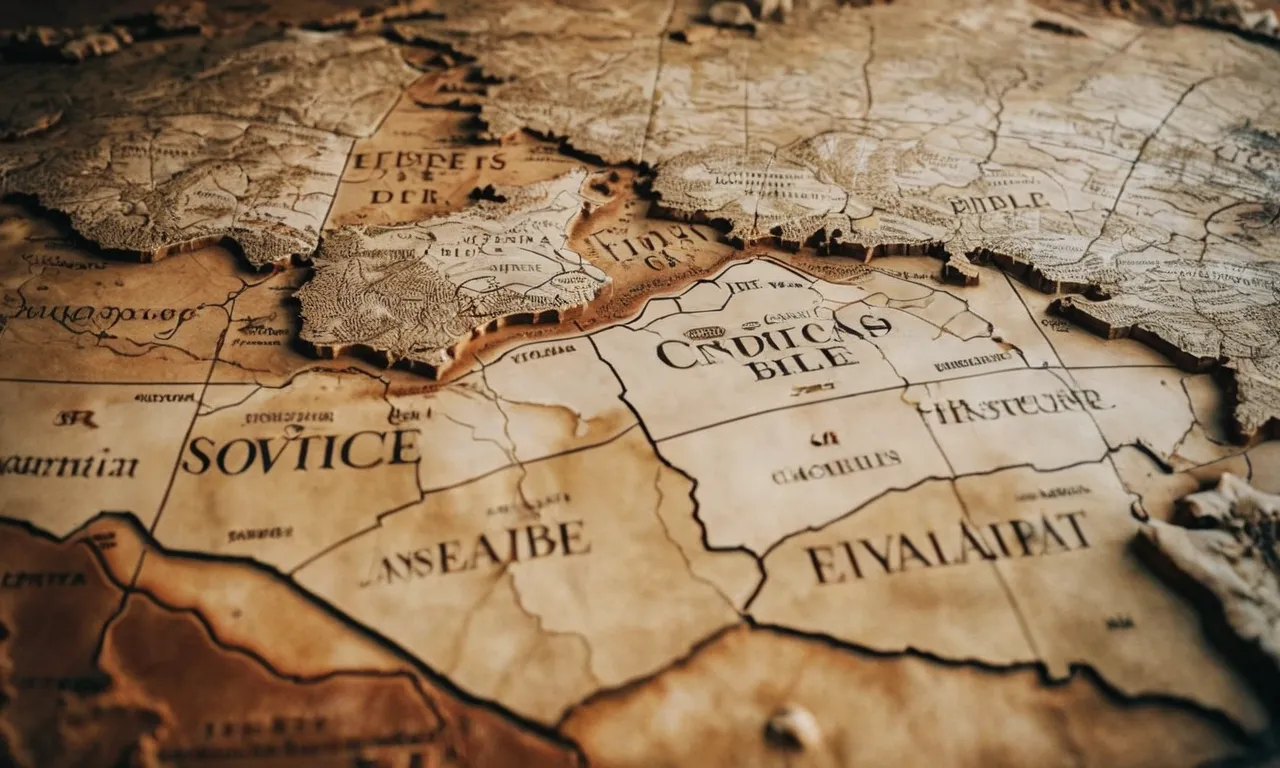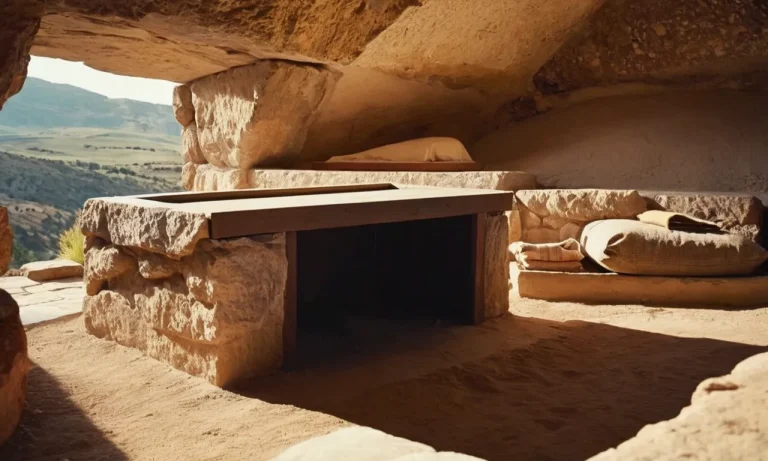When Did The Continents Split According To The Bible?
The question of when the continents split and drifted apart to form the current world map has long fascinated people. If you’re short on time, here’s a quick answer: the Bible does not provide an exact date or timeframe for when continent division occurred.
In this comprehensive article, we will analyze relevant biblical passages to extract clues about the timing of continental drift. We will also explore scientific theories and discoveries regarding continental shift to see how they may align with or differ from the biblical account.
Read on for a deep dive into this geological mystery and what the Judeo-Christian scriptures potentially reveal about it.
The Biblical Creation Account and the Supercontinent
The Premise of Pangea in Genesis 1
The opening verses of Genesis describe how God created the heavens and the earth. At first, the earth was “without form and void” with darkness over the surface of the deep while the Spirit of God hovered over the waters (Genesis 1:2).
This suggests that initially the earth was covered completely by water. God then commanded: “Let the waters under the heavens be gathered together into one place, and let the dry land appear.” And it was so (Genesis 1:9).
This implies that dry land emerged as the waters were gathered together in one place.
Many biblical scholars believe this passage refers to the formation of a single supercontinent surrounded completely by water, similar to the premise of Pangea before the continental plates began to drift apart around 200 million years ago.
The gathering of waters to allow dry land to emerge fits with the scientific theory of plate tectonics and Pangea’s initial unified landmass. This interpretation views the Genesis account as allegorical, with the sequence of creation events not necessarily chronological.
Land and Water Boundaries Established
As the creation narrative continues in Genesis 1, God further defines the boundaries between land and water: “Let the waters under the heavens be gathered together into one place, and let the dry land appear.” And it was so.
God called the dry land Earth, and the waters that were gathered together he called Seas (Genesis 1:9-10). This establishes distinct land and water areas on the earth.
Again, this aligns with the premise of Pangea as a supercontinent surrounded completely by a single ocean. The continental plates that eventually divided Pangea were initially joined as a unified landmass, with a vast ocean surrounding the supercontinent.
The Genesis account does not provide specifics on the shape or size of the original landmass and ocean, but the basic boundaries described match the Pangean concept.
Clues About Continental Drift Post-Creation
Genesis Flood Narrative Hints
The biblical Genesis flood narrative provides some clues that continental drift occurred after creation. According to Genesis, there was once a supercontinent and a single land mass before the Flood. The catastrophic flooding likely caused tectonic shifts that split the supercontinent into smaller continents and landmasses.
This matches secular theories about continental drift after the initial splitting of the supercontinent Pangea.
Additional evidence from the Flood account pointing to post-creation continental drift includes:
- Marine fossils found atop tall mountains, indicating the mountains formed after water covered the land
- Rapid formation of immense canyons, unlikely without significant tectonic shifts
- Widespread sedimentary rock layers from massive Flood water movements
While the Bible does not provide definitive timing details, combining the scientific theory of plate tectonics with the Genesis narrative suggests the continents divided sometime between creation and the Great Flood – rather than hundreds of millions of years ago.
This matches arguments made by some creation scientists like John Baumgardner.
Tower of Babel Migration as Evidence
The dispersion of humanity across continents and landmasses after the Tower of Babel account in Genesis 11 also points to continental drift shortly after creation, rather than in deep time. Scripture mentions the people settling in various lands and terrains, implying accessible migration routes between continents still close together or connected by land bridges after the Flood waters receded.
However, within just a few generations, the continents had already significantly separated to inhibit further intercontinental human migration and settling for thousands of years until advanced modern sea travel.
| Years from Creation to Babel Dispersion | 100 – 300 years |
| Years from Babel Dispersion to Present | over 4,000 years |
So within a tiny fraction of world history, early people groups were able to migrate between continents and lands which soon after became too remote for millennia. This fits a young-earth model with continental division quite soon after creation, aligning with clues from the Genesis flood account.
More research is still needed, but significant strides have been made in this area of study.
Scientific Theories on Continental Drift Timelines
Early Evidence and Hypotheses
The idea that the continents were once joined together and have since drifted apart has been around for centuries. As early as 1596, the Dutch mapmaker Abraham Ortelius hypothesized that the continents were once joined and had fragmented apart.
In 1858, Antonio Snider-Pellegrini drew detailed maps showing how the continents may have been joined together in the past. He posited that the fragmentation of a supercontinent occurred hundreds of millions of years ago.
However, these early ideas were speculative and not backed up by much concrete evidence or data.
In the early 20th century, the German meteorologist Alfred Wegener reintroduced the theory of continental drift. In his 1915 book “The Origin of Continents and Oceans,” Wegener pointed out that the coastlines of continents like Africa and South America fit together like puzzle pieces.
He also showed that the same fossil plants and animals were found on lands now widely separated by oceans. Wegener proposed that 200 million years ago, all continents were joined together in a single supercontinent called Pangaea.
According to his theory, Pangaea later broke up and the fragments drifted to their current positions. However, Wegener could not explain the forces that drove this drift.
While Wegener’s theory was ridiculed by many geologists at the time, new evidence in its favor continued to accumulate. The matching of rock layers, fossil types, and geologic structures across continents provided more clues that they were once connected.
Measurements showed that Greenland and Europe were moving apart at about 1-2 cm per year. Geophysical evidence also revealed a mid-ocean ridge system where new seafloor was being created.
Plate Tectonics and Pangea Breakup Models
The theory of plate tectonics, which emerged in the 1960s, finally provided a mechanism for continental drift and largely confirmed Wegener’s ideas. According to plate tectonics theory, Earth’s outer shell consists of lithospheric plates that move slowly over the inner mantle layer.
Convection currents in the mantle produce new crust at mid-ocean ridges, and old crust is recycled back into the mantle at subduction zones. This accounts for the seafloor spreading and continental drift.
Using data from paleomagnetism, seafloor spreading rates, plate motions, and geologic clues, scientists have reconstructed models showing the breakup sequence of the supercontinent Pangaea. The leading models suggest that Pangaea began rifting about 240-200 million years ago in the late Triassic.
Initial rifting caused North America and northwest Africa to separate from the rest of Pangaea. Further rifting then split Pangaea into two large continents: Laurasia in the north and Gondwanaland in the south.
Laurasia consisted of North America, Greenland and Eurasia, while Gondwanaland was made up of South America, Africa, Antarctica, India and Australia.
By about 120 million years ago in the early Cretaceous, Gondwanaland had separated into the continents we know today. Meanwhile, North America started breaking away from Eurasia, opening the northern Atlantic Ocean.
The Indian Plate split off from Gondwanaland and headed northward, eventually colliding with Eurasia around 50-40 million years ago. This collision uplifted the Himalayas. The last connection between North and South America was severed around 2-3 million years ago with the complete opening of the Isthmus of Panama.
While details are still being refined, scientific findings continue to support Wegener’s century-old vision of moving and splitting continents over geologic time. Developments like GPS and satellite data are further enhancing our understanding of plate motions.
The unfolding evidence makes the theory of plate tectonics one of the great scientific revolutions and triumphs of human inquiry.
Attempts to Reconcile the Biblical and Scientific Views
There have been various attempts throughout history to reconcile the biblical account of creation and the splitting of continents with the scientific evidence and theories surrounding continental drift and plate tectonics. Some of the key attempts include:
Attempts to Match Biblical Chronology
Some have tried to precisely date the splitting of continents based on biblical chronology. For example, the 17th century scholar James Ussher dated the creation of the world to 4004 BC, and the Noachian Flood to around 2348 BC.
Using these dates, some have speculated the splitting of continents occurred during or soon after the Flood. However, such precise dating is highly questionable from a scientific perspective.
Flood Geology
Proponents of Flood geology argue that the violent upheavals caused by the Noachian Flood could have led to the rapid splitting and drifting of continents. However, most geologists maintain that such catastrophic changes are not supported by geological evidence, which points to slow plate motions over hundreds of millions of years.
Attempts to Incorporate Plate Tectonics
Some Christian geologists and old-Earth creationists argue that the biblical account of creation and the Flood can be reconciled with standard geological evidence for plate tectonics. They propose that continents initially joined together during creation, later split apart gradually by tectonic processes, and were further shaped by catastrophic regional flooding.
While providing a plausible harmonization, such views tend to reject a literal 6-day creation and young-Earth chronology.
Metaphorical Interpretations
Rather than focusing on precise dating, some see references to land and water divisions in Genesis as ancient phenomenological language describing changes observable in that time, not technical references to modern continental drift.
This allows for concordance with science while maintaining biblical authority regarding spiritual truths.
There is still much debate around reconciling biblical and scientific accounts regarding continents dividing. While some harmonizations have been proposed, there remains tensions around precise chronology, explanatory mechanisms proposed, and degree of biblical literalism.
This is an area where ongoing discussions between biblical scholars, theologians, and scientists are valuable.
Conclusion
In closing, while the Bible does not provide definitive timing details, analysis allows us to extract some clues regarding major Earth changes like continental drift after the Creation period.
By reviewing Genesis flood accounts, migration mentions, and tracing the roots of ancient civilizations, tentative biblical timeframes emerge. While vast uncertainties remain, we have explored how the scriptural perspective allows room for modern plate tectonics discoveries of Pangea and continental shift.








